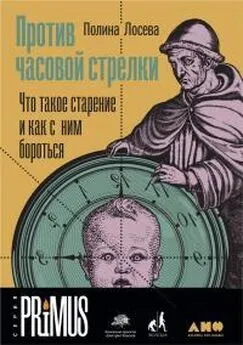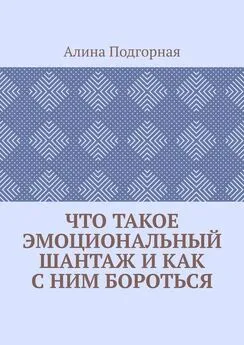Полина Лосева - Против часовой стрелки. Что такое старение и как с ним бороться
- Название:Против часовой стрелки. Что такое старение и как с ним бороться
- Автор:
- Жанр:
- Издательство:Альпина нон-фикшн
- Год:2020
- Город:Москва
- ISBN:978-5-0013-9314-6
- Рейтинг:
- Избранное:Добавить в избранное
-
Отзывы:
-
Ваша оценка:
Полина Лосева - Против часовой стрелки. Что такое старение и как с ним бороться краткое содержание
В своей книге биолог и научный журналист Полина Лосева выступает в роли адвоката современной науки о старении и рассказывает о том, чем сегодня занимаются геронтологи и как правильно интерпретировать полученные ими результаты. Кто виноват в том, что мы стареем? Что может стать нашей защитой от старости: теломераза или антиоксиданты, гормоны или диеты? Биологи пока не пришли к единому ответу на эти вопросы, и читателю, если он решится перейти от размышлений к действиям, предстоит сделать собственный выбор.
Эта книга станет путеводителем по современным теориям старения не только для биологов, но и для всех, кому интересно, как помочь своему телу вести неравную борьбу со временем.
Против часовой стрелки. Что такое старение и как с ним бороться - читать онлайн бесплатно ознакомительный отрывок
Интервал:
Закладка:
108
Santiago-Fernández. O. et al. Development of a CRISPR/Cas9-based therapy for Hutchinson – Gilford progeria syndrome // Nature Medicine. 2019 Feb; 25: 423–426.
109
Beyret E. et al. Single-dose CRISPR-Cas9 therapy extends lifespan of mice with Hutchinson – Gilford progeria syndrome // Nature Medicine. 2019 Feb; 25: 419–422.
110
Poulain et al. Identification of a geographic area characterized by extreme longevity in the Sardinia island: the AKEA study // Experimental Gerontology. 2004 Sep; 39 (9): 1423–1429.
111
Buettner D. The Blue Zones, Second Edition: 9 lessons for living longer from the people who've lived the longest. National Geographic Books, 2012.
112
Poulain M., Herm A., Pes G. The Blue Zones: areas of exceptional longevity around the world // Vienna Yearbook of Population Research. 2013; 11: 87–108.
113
Medvedev Z. A. Caucasus and Altay longevity: a biological or social problem? // The Gerontologist. 1974 Oct; 14 (5p1): 381–387.
114
Buettner D., Skemp S. Blue Zones: lessons from the world's longest lived // American Journal of Lifestyle Medicine. 2016 Mar;10 (5): 318–321.
115
Perls T. Dementia-free centenarians // Experimental Gerontology. 2004 Nov – Dec; 39 (11–12): 1587–1593.
116
Kedlian V. R., Donertas H. M., Thornton J. M. The widespread increase in inter-individual variability of gene expression in the human brain with age // Aging. 2019 Apr; 11 (8): 2253–2280.
117
Ostan R. et al. Heterogeneity of thyroid function and impact of peripheral thyroxine deiodination in centenarians and semi-supercentenarians: association with functional status and mortality // The Journals of Gerontology: Series A. 2019 Jun; 74 (6): 802–810.
118
Bunning B. J. et al. Global metabolic profiling to model biological processes of aging in twins // Aging Cell. 2019 Oct; 19: e13073.
119
Franceschi C., Ostan R., Santoro A. Nutrition and Inflammation: Are Centenarians Similar to Individuals on Calorie-Restricted Diets? // Annual Review of Nutrition. 2018 May; 38: 329–356.
120
Pignolo R. J. Exceptional human longevity // Mayo Clinic Proceedings. 2019 Jan; 94 (1): 110–124.
121
Horvath S. et al. Decreased epigenetic age of PBMCs from Italian semi-supercentenarians and their offspring // Aging. 2015 Dec; 7 (12): 1159–1170.
122
Alzheimer's association. 2018 Alzheimer's disease facts and figures // Alzheimer's & Dementia. 2018 Mar; 14 (3): 367–429.
123
Franceschi C. et al. Accelerated bio‐cognitive aging in Down syndrome: State of the art and possible deceleration strategies // Aging Cell. 2019 Feb; 18 (3): e12903.
124
Horvath S. Accelerated epigenetic aging in Down syndrome // Aging Cell. 14 (3): 491–495.
125
Armenian S. H., Gibson C. J., Rockne R. C., Ness K. K. Premature aging in young cancer survivors // Journal of the National Cancer Institute. 2019 Mar; 111 (3): 226–232.
126
Hill A., Sadda J., LaBarge M. A., Hurria A. How cancer therapeutics cause accelerated aging: Insights from the hallmarks of aging // Journal of Geriatric Oncology. 2019 Mar.
127
De Francesco D. et al. Do people living with HIV experience greater age advancement than their HIV-negative counterparts? // AIDS. 2019 Feb; 33 (2): 259–268.
128
Franceschi C. et al. The Continuum of Aging and Age-Related Diseases: Common Mechanisms but Different Rates // Frontiers in Medicine. 2018 Mar; 5: 61.
129
Hindhede M. The effect of food restriction during war on mortality in Copenhagen // JAMA. 1920 Feb; 74 (6): 381–382.
130
https://calerie.duke.edu/home.
131
Ravussin E. et al. A 2-Year Randomized Controlled Trial of Human Caloric Restriction: Feasibility and Effects on Predictors of Health Span and Longevity // The Journals of Gerontology: Series A. 2015 Sep; 70 (9): 1097–1104.
132
Bartke A. et al. Extending the lifespan of long-lived mice // Nature. 2001 Nov; 414: 412.
133
Rose M. R. et al. Evolution of late-life mortality in Drosophila melanogaster // Evolution.. 2002 Oct; 56 (10): 1982–1991.
134
Ayyadevara S… Alla R… Thaden J. .J., Shmookler Reis R. .J. Remarkable longevity and stress resistance of nematode PI3K-null mutants // Aging Cell.. 2008 Jan; 7 (1): 13–22.
135
De Grey A. D. N. J. Resistance to debate on how to postpone ageing is delaying progress and costing lives // EMBO Reports. 2005 Jul; 6 (suppl 1): S49–S53.
136
Kaeberlein M., Galvan V. Rapamycin and Alzheimer's disease: Time for a clinical trial? // Science Translational Medicine. 2019 Jan; 11 (476): eaar4289.
137
https://www.nia.nih.gov/research/blog/2018/10/we-have-budget-fy-2019.
138
https://www.kff.org/hivaids/fact-sheet/u-s-federal-funding-for-hivaids-trends-over-time ./
139
De Grey A. D. N. J. An Engineer's Approach to the Development of Real Anti-Aging Medicine // Science of Aging Knowledge Environment. 2003 Jan; 2003 (1): vp1.
140
https://www.sens.org ./
141
De Grey A. D. N. J. Time to Talk SENS: Critiquing the Immutability of Human Aging // Annals of the New York Academy of Sciences. 2006 Jan; 959 (1): 452–462.
142
http://scienceagainstaging.com/foundation.
143
López-Otín C., Blasco M. A., Partridge L., Serrano M., Kroemer G. The hallmarks of aging // Cell. 2013 Jun; 153 (6): 1194–1217.
144
Warner H. et al. Science fact and the SENS agenda // EMBO Reports. 2005 Nov; 6 (11): 1006–1008.
145
Demeyer D., Mertens B., De Smet S., Ulens M. Mechanisms Linking Colorectal Cancer to the Consumption of (Processed) Red Meat: A Review // Critical Reviews in Food Science and Nutrition. 2016 Aug; 56 (16): 2747–2766.
146
https://www.wcrf.org/dietandcancer/recommendations/limit-red-processed-meat.
147
Alshahrani S. M. et al. Red and Processed Meat and Mortality in a Low Meat Intake Population // Nutrients. 2019 Mar; 11 (3): 622.
148
Cucinotta F. A. Space Radiation Risks for Astronauts on Multiple International Space Station Missions // PLOS One. 2014 Apr; 9 (4): e96099.
149
Khrapko K., Vijg J. Mitochondrial DNA mutations and aging: devils in the details? // Trends in Genetics. 2009 Feb; 25 (2): 91–98.
150
Hiona A., Leeuwenburgh C. The role of mitochondrial DNA mutations in aging and sarcopenia: Implications for the mitochondrial vicious cycle theory of aging // Experimental Gerontology. 2008 Jan; 43 (1): 24–33.
151
Swerdlow R. H., Burns J. M., Khan S. M. The Alzheimer's disease mitochondrial cascade hypothesis // Journal of Alzheimers Disease. 2010 Jun; 20 (Suppl 2): 265–279.
152
Hämäläinen. R. H. Defects in mtDNA replication challenge nuclear genome stability through nucleotide depletion and provide a unifying mechanism for mouse progerias // Nature Metabolism. 2019 Oct; 1: 958–965.
153
McCulloch S. D., Kunkel T. A. The fidelity of DNA synthesis by eukaryotic replicative and translesion synthesis polymerases // Cell Research. 2008 Jan; 18 (1): 148–161.
154
Martincorena I., Campbell I. Somatic mutation in cancer and normal cells // Science. 2015 Sep; 349 (6255): 1483–1489.
155
Andriani G. A., Vijg J., Montagna C. Mechanisms and consequences of aneuploidy and chromosome instability in the aging brain // Mechanisms of Ageing and Development. 2017 Jan; 161 (A): 19–36.
156
Zasadil L. M., Britigan E. M., Weaver B. A. 2n or not 2n: Aneuploidy, polyploidy and chromosomal instability in primary and tumor cells // Seminars in Cell & Developmental Biology.. 2013 Apr; 24 (4): 370–379.
157
Kaushai et al. Alteration of gene expression by chromosome loss in the postnatal mouse brain // Journal of Neuroscience. 2003 Jul; 23 (13): 5599–5606.
158
Duncan A. W. et al. Aneuploidy as a mechanism for stress-induced liver adaptation // Journal of Clinical Investigation. 2012 Sep; 122 (9): 3307–3315.
159
Hancks D. C., Kazazian H. H. Active human retrotransposons: variation and disease // Current Opinion in Genetics & Development.. 2012 Jun; 22 (3): 191–203.
160
De Koning A. P. J., Gu W., Castor T. A., Batzer M. A., Pollock D. D. Repetitive Elements May Comprise Over Two-Thirds of the Human Genome // PLOS Genetics. 2011 Dec; 7 (12): e1002384.
161
Palazzo A. F., Gregory T. R. The case for junk DNA // PLOS Genetics. 2014 May; 10 (5): e1004351.
162
Kazazian H. H. Mobile elements: drivers of genome evolution // Science. 2004 Mar; 303 (5664): 1626–1632.
163
См. п. 15.
164
Rodić. N. et al. Long interspersed element-1 protein expression is a hallmark of many human cancers // The American Journal of Pathology.. 2014 May; 184 (5): 1280–1286.
165
De Cecco M. et al. Genomes of replicatively senescent cells undergo global epigenetic changes leading to gene silencing and activation of transposable elements // Aging Cell. 2013 Jan; 12 (2): 247–256.
166
Erwin J. A., Marchetto M. C., Gage F. H. Mobile DNA elements in the generation of diversity and complexity in the brain // Nature Reviews Neuroscience. 2014 Jul; 15: 497–506.
167
Muotri A. R., Zhao C., Marchetto M. C. N., Gage F. H. Environmental influence on L1 retrotransposons in the adult hippocampus // Hippocampus. 2009 Sep; 19 (10): 1002–1007.
168
Anisimova A. S., Alexandrov A. I., Makarova N. E., Gladyshev V. N., Dmitriev S. E. Protein synthesis and quality control in aging // Aging. 2018 Dec; 10 (12): 4269–4288.
169
Ke Z. et al. Translation fidelity coevolves with longevity // Aging Cell. 2017 Jul; 16 (5): 988–993.
170
Yin D., Chen K. The essential mechanisms of aging: Irreparable damage accumulation of biochemical side-reactions // Experimental Gerontology.. 2005 Jun; 40 (6): 455–465.
171
Hunter S. J. et al. Demonstration of glycated insulin in human diabetic plasma and decreased biological activity assessed by euglycemic-hyperinsulinemic clamp technique in humans // Diabetes. 2003 Feb; 52 (2): 492–498.
172
Интервал:
Закладка:










